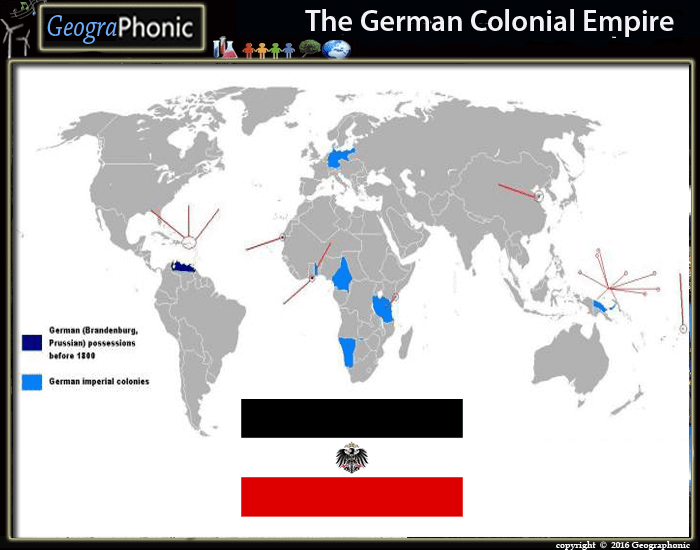GERMANY’S COLONIAL HISTORY
December 12, 2020

Under Chancellor Otto von Bismarck, Germany’s colonial empire was established on territories in present-day Namibia, Cameroon, Togo, parts of Tanzania and Kenya. Emperor Wilhelm II, crowned in 1888, sought to further expand colonial possessions by establishing new fleets (picture). The German Empire wanted its “place in the sun,” declared a later chancellor, Bernhard von Bülow, in 1897.

Acquisitions were made in the Pacific (North New Guinea, Bismarck Archipelago, Marshall and Solomon Islands, Samoa) and in China (Tsingtao). A conference in Brussels in 1890 determined that the German Empire would obtain the kingdoms of Rwanda and Burundi, connecting them to German East Africa. By the end of the 19th century, Germany’s colonial conquests were largely completed.

The “white” population in the colonies was a small, highly privileged minority – rarely more than one percent of the population. In 1914, about 25,000 Germans lived in the colonies, slightly less than half of them in German South-West Africa. The 13 million natives in the German colonies were seen as subordinates, with no access to legal recourse.

The first genocide of the 20th century
The genocide against the Herero and Nama in German South-West Africa (present-day Namibia) is the most serious crime in Germany’s colonial history. During the Battle of Waterberg in 1904, most Herero rebels escaped into the desert, where German troops systematically blocked their access to water. More than 60,000 Herero are estimated to have perished.

Only about 16,000 Herero survived the extermination campaign. They were then detained in concentration camps, where many more died. The exact number of victims was never established and remains a point of controversy. How long did these emaciated Herero survive after fleeing through the desert? At any rate, they had lost all personal possessions, livelihood and future perspectives.

From 1905 to 1907, a broad alliance of ethnic groups rose against colonial rule in German East Africa. An estimated 100,000 locals died in the Maji-Maji Rebellion. Although hardly ever discussed in Germany afterwards, it remains an important chapter in the history of Tanzania.

In the aftermath of the colonial wars, administration in the German colonies was restructured with the aim of improving living conditions there. Bernhard Dernburg, a successful entrepreneur (pictured being carried in German East Africa), was appointed Secretary of State for Colonial Affairs in 1907 and introduced reforms in Germany’s colonial policies.

Along with Dernburg’s reforms, scientific and technical institutions were established to deal with colonial issues, creating faculties at today’s universities of Hamburg and Kassel. In 1906, Robert Koch directed a long expedition to East Africa to investigate the transmission of sleeping sickness. Pictured above are microscopic specimens collected there.

The Prussian Cultural Heritage Foundation, the group administering Berlin’s state museums holds more than 1,000 skulls originating from Rwanda and some 60 from Tanzania. Both countries belonged to the German East Africa colony from 1885 to 1918. Some of the remains are believed to have come from insurgents who were killed by German troops during the colonial wars. Their skulls were subsequently sent to Berlin for “scientific” experiments. The Foundation has held the so-called Luschan Collection of remains since late-2011, to which the skulls currently belong. Among the artifacts, there are some 4,600 other skulls collected by researcher Felix Luschan between 1885 and 1920. Recently, Germany has been prompted by former colonies to return the remains of indigenous inhabitants of the former German colonies.

Defeated in World War I, Germany signed the peace treaty in Versailles in 1919 specifiying that the country would renounce sovereignty over its colonies. Posters like this depicted Germans’ consequent fear of lost economic power, poverty and misery in the homeland.

Colonial aspirations resurged under the Nazis – and not just the ones laid out in the “Generalplan Ost,” which outlined the colonization of Central and Eastern Europe by means of genocide and ethnic cleansing. The Nazis also aimed to recover the country’s lost African colonies, as is evident in this school map from 1938. They were to provide resources to Germany.

Negotiations for a joint declaration on the genocide of the Herero and Nama are now entering a difficult phase. While Germany stalls when it comes to financial compensation, there are also shortcomings in the internal political structures of Namibia. Herero representatives recently filed a formal complaint to the UN to object their exclusion from the current negotiations.
Source: dw.com
Like
Recent posts

Papal Bull of 1455, Romanus Pontifex
This Bull authorised Portugal to raid African Kingdoms, territories and land, capture and enslave the inhabitants and seize their natural and mineral resources, under the authority of the Pope and the Catholic Church.

The Reign of Elizabeth II
A summary of the reign of Elizabeth II and events that took place during her reign
Previous post
KILLED BY NAZIS: MAHJUB BIN ADAM MOHAMED


